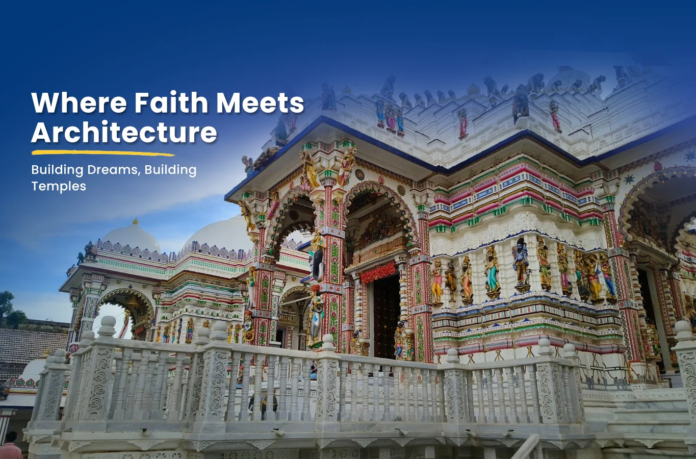entity. In Maharashtra, where diverse religious practices and rich architectural heritage coexist, the approaches to temple construction have evolved. This article explores the traditional and modern methods in temple construction services, highlighting their significance and the interplay between the two.
Traditional Approaches to Temple Construction
Architectural Styles and Symbolism
Traditional temple construction in Maharashtra is characterized by distinct architectural styles, such as the Hemadpanthi style and the Nagara style. These styles emphasize intricate carvings, domes, and sculptures that embody religious symbolism and local mythology. The use of materials like stone and wood not only reflects the region’s heritage but also ensures durability. Each design element serves a purpose, whether it’s to channel energy, tell a story, or create a spiritual ambiance.
Local Artisans and Craftsmanship
One of the hallmarks of traditional temple construction is the involvement of local artisans and craftsmen. These skilled individuals possess specialized knowledge passed down through generations. Their expertise in stone carving, woodwork, and metalwork adds authenticity and depth to the construction process. The attention to detail in traditional craftsmanship ensures that every temple is unique and resonates with the local culture.
Ritualistic Significance
In traditional temple construction, the process is often steeped in rituals and spiritual practices. From the selection of the site to the placement of the deities, each step is guided by religious beliefs and customs. Architects and contractors often consult priests and community leaders to ensure that the construction aligns with spiritual principles. This ritualistic aspect is vital in creating a sacred space that fosters devotion and connection.
Use of Local Materials
Traditionally, temple construction relies heavily on locally sourced materials. This practice not only supports the local economy but also ensures that the materials are suitable for the region’s climate and geography. For instance, the use of basalt stone in certain areas enhances durability while blending harmoniously with the surrounding landscape. This local approach also reflects the cultural identity of the community.
Modern Approaches to Temple Construction
- Innovative Design and Engineering
Modern temple construction incorporates innovative design principles and engineering techniques. Architects and contractors now leverage advanced software for design visualization and structural analysis, ensuring that the temple is both aesthetically pleasing and structurally sound. These tools allow for creative interpretations of traditional designs, making room for contemporary aesthetics while respecting cultural significance.
- Sustainable Practices
With a growing emphasis on sustainability, modern temple construction often integrates eco-friendly practices. This includes using renewable materials, energy-efficient technologies, and sustainable building techniques. Contractors may implement rainwater harvesting systems, solar panels, and other green technologies to minimize the temple’s environmental impact. This shift towards sustainability reflects a broader awareness of ecological responsibility, which is becoming increasingly important in all forms of construction.
- Collaboration with Technology
The modern approach to temple construction embraces technology at every stage of the process. Contractors often use Building Information Modeling (BIM) to enhance project planning and execution. This technology enables better collaboration among architects, engineers, and builders, resulting in improved accuracy, efficiency, and cost-effectiveness. Drones and 3D printing are also beginning to play roles in surveying, site analysis, and even creating intricate design elements.
- Incorporating Community Feedback
Unlike traditional methods, where decisions were primarily made by a select few, modern temple construction increasingly values community input. Contractors and architects often engage with local communities to gather feedback on design and functionality. This inclusive approach fosters a sense of ownership among community members, ensuring that the temple meets the needs and desires of those it serves.
The Interplay Between Tradition and Modernity
While traditional and modern approaches to temple construction may seem distinct, they can effectively complement one another. Many contractors today aim to strike a balance between respecting traditional craftsmanship and embracing modern technology. For instance, while using advanced construction techniques, they might still hire local artisans for specific elements that require traditional skills. This synthesis can lead to the creation of temples that are not only spiritually significant but also reflect contemporary architectural trends.
Conclusion
In Maharashtra, the evolution of temple construction services illustrates a dynamic interplay between tradition and modernity. By understanding and appreciating both approaches, builders and communities can create temples that honor their rich cultural heritage while also addressing contemporary needs. Whether through traditional craftsmanship or modern innovation, the goal remains the same: to build sacred spaces that foster spiritual connection and community identity.
If you are seeking reliable and skilled temple construction services, consider Temple Contractor in Maharashtra. Their commitment to blending traditional techniques with modern approaches ensures that every temple is a true reflection of both heritage and innovation, providing a space that resonates with the community and enhances spiritual devotion.


